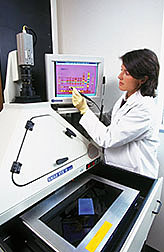Elusive Bacteria Pinpointed With DNA Tests
|
|
New tests developed by ARS scientists can identify pathogenic bacteria that attack strawberries and citrus. Positive identification of two previously elusive bacteria can now be made quickly and easily.
Speed is important, says geneticist Margaret Pooler, because "by the time leaves on a strawberry plant look scorched or blighted, it's too late to treat it for angular leaf spot disease.
"The same holds true for citrus. Mottled patches on citrus leaves could mean that the tree is already infected with citrus variegated chlorosis (CVC), a bacterial disease," she says.
Pooler, along with plant pathologist John Hartung at the ARS Fruit Laboratory in Beltsville, Maryland, developed new diagnostic tests for the bacteria that cause these diseases.
Using a method based on polymerase chain reaction (PCR)—a technique that relies on genetic information—they identify pathogenic strains of the bacteria by specific regions of their DNA.
One of the diseases, angular leaf spot of strawberries, is caused by a bacterium Xanthomonas fragariae, which is classified as a quarantine pest. Transport of affected commodities is restricted to prevent its spread.
The only bacterial disease affecting domestic strawberries, angular leaf spot is found throughout the United States—including in California and Florida, major U.S. production states—as well as in other strawberry growing areas of the world. To keep out the disease, Europeans now test imported strawberry plant material, says John L. Maas, a plant pathologist at the Beltsville Fruit Laboratory.
"Up to 80 percent of a crop can be lost to this disease once it starts, because there is no way to stop it," he says. "Copper-based chemicals are used, but they just delay the symptoms without killing the bacteria. The only way to eradicate the disease is to catch it at the nursery level and destroy infected plants before they can spread the bacteria."
And that's what the new tests help to do. Even if symptoms have not appeared in infected plants, the DNA test will show X. fragariae's presence.
Without the PCR test, to detect this pathogen, "we must isolate, culture, and test the organism for pathogenicity—all of which take time," Pooler says. "Even then, identifying X. fragariae is complicated because other yellow-colored, nonharmful bacteria commonly found on strawberry tissues have similar characteristics and growth rates.
"We studied the genetic relationships among 26 strains of X. fragariae from 6 countries," she continues. "Our test results show that while the pathogenic strains are closely related, their DNA is clearly distinguishable from that of harmless strains."
Pooler found no correlation between DNA patterns and geographic sites, which suggests that X. fragariae has been spread unintentionally through exchange of infected plant material. Although it does not survive free in the soil, it infects new spring growth through overwintering of dead, infected leaves and from living, systemically infected plants.
Though not yet occurring in the United States, citrus variegated chlorosis—caused by Xylella fastidiosa—is another potential threat. According to Tim Gottwald, an ARS plant pathologist in Orlando, Florida, "there is no known chemical control for CVC. Growers in Brazil and northern Argentina are attempting to control it by removing affected trees, but the success of this method has not yet been determined."
Spread by an insect pest or through grafting, CVC is known to be carried by leafhoppers. X. fastidiosa also causes other disorders, such as Pierce's disease of grapevines. Fruits from affected trees mature early and are small and hard. Says Gottwald, "Because the hardened fruit can damage juicing machines, the fruit is practically unmarketable."
The new ARS test identifies X. fastidiosa and can distinguish between the strains that cause CVC and other strains already present in the United States. The test is also being used to determine if an insect is carrying X. fastidiosa.— By Doris Stanley, ARS.
Margaret Pooler, is at the USDA-ARS Floral and Nursery Plants Research Unit, National Arboretum and John Hartung is at the USDA-ARS Fruit Laboratory, Beltsville, MD 20705.
"Elusive Bacteria Pinpointed With DNA Tests" was published in the June 1996 issue of Agricultural Research magazine.







